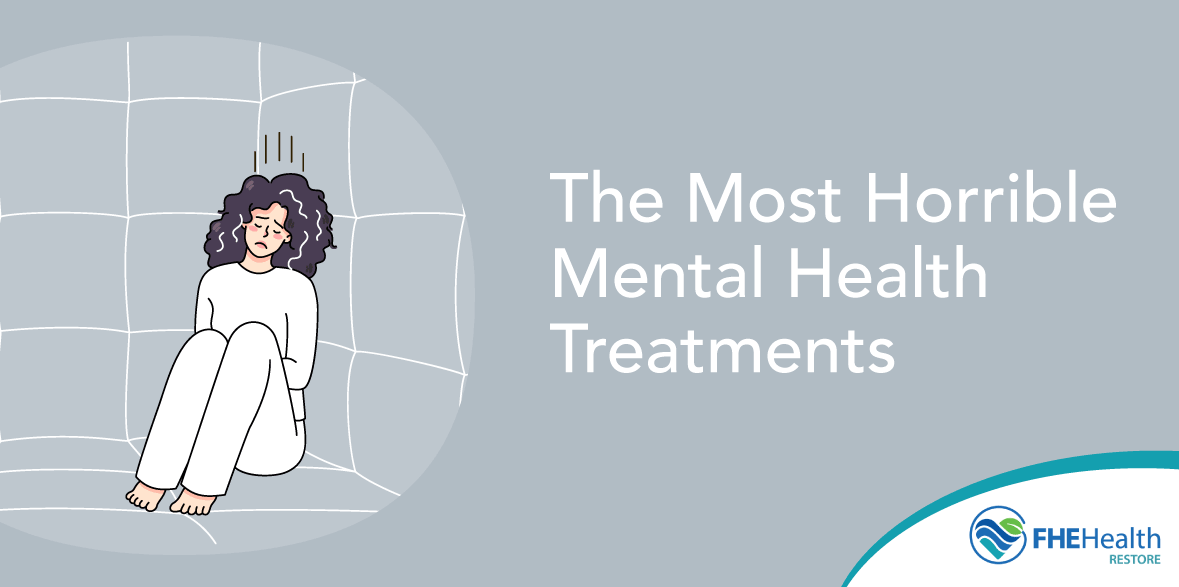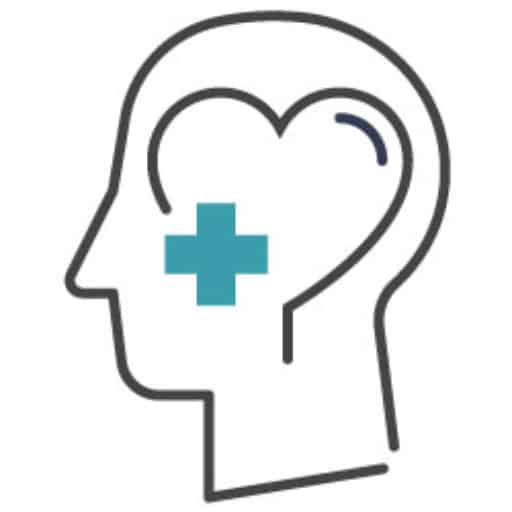We are lucky to live in an era when mental health is taken seriously and scientifically backed treatments are widely available most of the time. Unfortunately, this was not always the case. In the past, those with mental illness were often made to live in asylums or forced to undergo strange, cruel, or dangerous treatments.
This list of 13 of the most horrible mental health treatments throughout history may shock you….
13 Horrible Asylum Treatments Throughout Time
1. Religion and Moral Discipline
While there has always been sympathy and understanding for those with physical illnesses, mental illness treatments in the 1800s were not nearly as sympathetic.
For most of human history, religion and psychiatry were extremely closely connected. Up until about the 19th century, religious institutions were typically responsible for caring for anyone who was deemed mentally ill. Experts of the time believed that mental health conditions occurred primarily for three reasons: an evil spirit was possessing the individual, they were simply immoral, or they were the victim of- or a practitioner of witchcraft. These problems, theoretically, were curable through religious and moral guidance.
To help individuals who were suffering from mental illnesses, doctors would try hospitalization, isolation and conversations about the individual’s “immoral beliefs.” In many cases, this would involve some form of exorcism, which often involved actions most modern people would consider abuse.
2. Lobotomy
Lobotomy is a surgical procedure meant to cure psychiatric disorders. The surgery involves severing connections in the brain’s prefrontal cortex to cure a person’s condition and alter their behavior.
The procedure was created by Portuguese neurologist António Egas Moniz, for which he received the Nobel Prize in Physiology or Medicine. However, lobotomy has always been controversial due to its inconsistent, risky results. Many patients’s behavior, personality, cognition and motor skills would be permanently altered after the surgery. The surgery left tens of thousands of people in a vegetative state and a significant percentage died.
Many of the doctors performing lobotomies, such as Walter Jackson Freeman II, were as much showmen as physicians. Freeman invented a simpler approach to lobotomy, allowing him to perform the surgeries outside of an operating theater. He took his procedure on the road, traveling the U.S. and performing more than 4,000 lobotomies on patients as young as 12. Freeman had no formal surgical training and was ultimately banned from performing surgeries in 1967—though his simpler lobotomy method had already spread around the world.
3. Bloodletting and purging
The ancient technique of bloodletting and purging began over 3,000 years ago. The method regained popularity in the 1600s when the physician Claudius Galen invented new therapies based on the ancient physician and philosopher Hippocrates’ humoral theory. According to this theory, illnesses come from an imbalance of humors (substances) in the body. Galen theorized that bloodletting, purging and vomiting could help rebalance the humors in the body and treat both physical and mental diseases.
In the 1600s, the English physician Thomas Willis came across Galen’s theory and decided to use this approach for mental health patients. It grew in popularity until it was prescribed for physical illnesses as well.
During the method’s infancy, bloodletting would occur through small incisions. Over time, different physicians adopted new tools and methodologies, with perhaps the most infamous being the use of leeches.
4. Straitjackets
Some old insane asylum treatments have endured into popular culture. The straitjacket is made so that a person’s arms are restrained firmly against their body. The restraints were designed so the patient might be kept calm and encouraged to “behave correctly,” but the results were questionable. At the height of its use, many doctors considered it one of the more humane options for pacifying patients because the material was less painful than ropes or chains.
5. Trephination
Trephination is one of the oldest mental health treatments in history, dating back to over 7,000 years ago. The procedure involved opening a hole in the skull with a bore, augur or saw and removing a piece of the skull. It’s believed this procedure was performed to treat mental illnesses and even quell demonic possession.
Doctors under Hippocrates in the fifth century BCE believed stagnant blood in the head could “spoil” and needed to be released. Of course, drilling into the skull carries severe risks, including brain damage, infection, blood loss, and even death due to trauma.
Interestingly, studies of prehistoric skulls show that the procedure had a high mortality rate, but that rate dropped dramatically with time. During the 16th and 17th centuries, experts believe that around 80% of patients survived trephination.
6. Insulin Coma Therapy
In the 1930s, a new approach to mental health treatment took the psychiatry world by storm. Doctors began to believe that dramatically changing insulin levels could “rewire” the brain and cure mental illness. The patient would receive drastic injections of insulin, which induced an approximately hour-long coma.
Though initial feedback was overwhelmingly positive, long-term effects included obesity and permanent brain damage with a significant fatality rate.
7. Fever Therapy
In the 1800s, Austrian psychiatrist Julius Wagner-Jauregg started inducing fevers to cure people of symptoms from other conditions. He started by giving a syphilis patient with malaria-infected blood. The patient developed an extremely high fever, which worked to kill the syphilis bacteria, and then was administered a drug to attack the malaria. This type of treatment was a popular way to treat malaria until the introduction of penicillin.
But Wagner-Jauregg didn’t stop there. He decided to expand this theory into the world of mental health and tried infecting schizophrenia patients with malaria blood. Of course, not only was this not effective, it was incredibly dangerous. Approximately 15% of patients who were given the malaria treatment died.
8. Isolation and Asylums
Asylums date back to medieval times and were largely a way to remove those with mental health issues from society. In the earliest days of asylums, communities would utilize already-existing prisons, rather than construct new structures. This meant that a person with mental health issues would often be held in the same space as a criminal, often against their will.
Though the story was that these people were sent to asylums to be treated, it was often so families could hide relatives who embarrassed them. One example of this occurred in 1941 when the royal family sent two first cousins of Queen Elizabeth to an asylum for having learning disabilities.
9. Metrazol Shock Therapy
In 1934, a Hungarian pathologist, Ladislas von Meduna, came up with the idea of shock therapy. Since schizophrenia was rare in epileptics, and people with epilepsy often feel better after a seizure, he theorized that inducing a seizure would help calm someone with schizophrenia.
Meduna chose Metrazol as his seizure-inducing drug of choice. The treatment did not work, however, and was quite dangerous. In 1939, it was found that a significant number of people who went through metrazol shock therapy suffered a fracture in their vertebrae.
10. Rotational Therapy
American physician Benjamin Rush, who signed the Declaration of Independence, would probably prefer to be remembered in history that way. Instead, many know him for his primitive and dangerous medical treatments. Among his many odd treatment methods was the already controversial practice of rotational therapy to treat mental illness. Rush believed that spinning could increase the circulation in the brain and, therefore, cure mental diseases.
To that end, Rush would sit a patient in a chair, elevate the chair using a pulley system, and then spin the patient around as fast as possible. This did have many effects, such as vertigo, nausea, vomiting, and urination, but did nothing for the patient’s mental health.
11. Hysteria Therapy
When a woman had a mental or physical problem, it was often diagnosed as hysteria. This vague diagnosis could cover fatigue, nausea, anxiety and a host of other symptoms, but it was most often used to disregard a woman’s mental health and well-being.
Doctors would often prescribe massages, a popular panacea of the time, to treat hysteria. Mechanical vibrators—the predecessor to the sex toy—could be used by doctors or patients to relax muscles in the back and shoulders.
12. Drugs
While the drugs used today for mental health conditions are tested and safe, that hasn’t always been the case. Throughout history, doctors have used dangerous and addictive drugs to treat mental health conditions. The highly toxic mercury was used to treat mania, and opium and morphine were regarded as cure-alls.
13. Sterilization
In 1927, the U.S. Supreme Court made a decision that many people consider to be one of the most harmful rulings in the country’s history. By a vote of 8 to 1, the Court upheld the States’ right to sterilize anyone who was deemed “unfit to procreate.” This overwhelmingly affected women, minorities, poor people, and people with mental health issues.
Records show that as many as 70,000 Americans were forcibly sterilized and many experts believe that number to be inaccurate due to poor recording. For men, the procedure was similar to a vasectomy. For women, the procedure of choice was a salpingectomy—cauterization of the path the egg takes. Often, doctors would not tell patients the truth about the procedure, instead choosing to lie and state they were performing another surgery, like an appendectomy.
Mental Health Treatment Has Come a Long Way
Despite it all, mental health care has progressed a lot over the last few centuries. The methods that experts use today are tested, reliable and safe, backed by significant research; and each new year contains still more exciting breakthroughs and advances in therapy and medications.
Wherever you are in your mental health journey, Restore Mental Health can help. Call us anytime.



